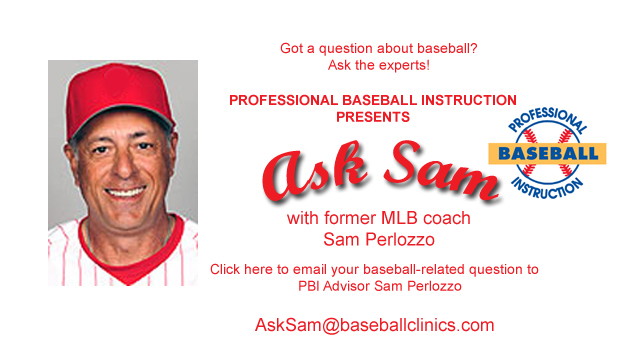
Former major league manager and coach, and PBI advisor Sam Perlozzo periodically answers your baseball-related questions. Email Sam directly – AskSam@baseballclinics.com. Here’s the latest from the “Ask Sam” mail bag.
Q: Sam – I know a lot of more traditional baseball coaches at the MLB level aren’t big fans of pitch counts, but there does seem to be a correlation between high pitch counts and injuries at just about every level of the game. Little League has had pitch count limits for a few years. Do you think high school pitchers should have a mandatory pitch count as well? – from Bob in Little Falls NJ
A: Good question Bob! I am and am not a big fan of pitch counts. I think simple common sense comes into play a lot. We used to groom our young players to throw a lot. Now we label them for shorter spots in the game, consequently they never learn to stretch out. I think there is a place though. Yes, I think Little Leagues need pitch counts and I also think high school players do also. As I said, common sense is your guide. There is a difference between the same pitch counts if one guy is laboring more than the other. That’s where coaches need to focus on. I’ve had to remove pitchers from games with a lot less pitches than others. The more they labor, the shorter you should let them go, as this is the reason injuries occur. Use your head on the pitch count, and keep a better eye on the intensity level of the guy throwing. That will help dictate when enough is enough. Good Luck. – Sam
Q: Sam – What is your opinion on sacrifice bunts? I hate giving other teams a sure out, especially in Little League games where you only have 18 outs to start with. – Mark, Rockland County NY
A: Mark – I agree with you on the sacrifice bunt. But I also think there is a time for it in the game. I don’t like it early in the game unless the pitcher is hitting. Late in the game is also a time when strategy to win the game is at the forefront. Kids learning to play need the confidence to let it rip and learn how to hit. I was once told I couldn’t bunt my way to the Big Leagues!! Hitting is having confidence and Little Leaguers need to learn how to hit. They have plenty of time to learn how to bunt!! So turn em’ loose and let them have some fun!! Good Luck. – Sam
Q: Sam, what’s the best way to teach young players (9-10 year olds) how to turn a double play? Should I even worry about DP’s given their age? – Tom, Paramus NJ
A: The DP is a 1-2-3 movement. Just like dancing…1-2-3. I will try and simplify it somewhat. The 2nd baseman gets to the bag as quickly as possible, catches throw with left foot on bag, (1), transfers weight to right foot (2), and throws (3). From SS, it’s the same but the SS drags his right foot across the bag, turns to 1st and throws. I wish I had the time to help you more because it can get a lot more technical than this. At least it’s a starting point for you. I taught this on an instructional video a few years back, not sure if I have any more though. Do the best you can and try and watch some Major Leaguers do it in the game. Good Luck. – Sam
Q: Sam, who was the toughest pitcher you faced? – Tony, Bloomfield NJ
A: Tony, I’ve faced some tough pitchers in my years in the game, but I’d have to say it is down to two guys. Eddie Watt and his side arm delivery was just nasty, and a guy named Juan Berenguer. He threw about 100 and never knew where it was going! I swung at the first pitch that didn’t hit me!!! Thanks. – Sam
Thanks to everyone for all the great questions. Send your questions to me via email – AskSam@baseballclinics.com.






Runners on second and third, no outs, pitcher is in the full, a bunt play is on. Where do you bunt the ball?
I’m not sure you’d want to bunt the ball in that situation. There’s no conventional double play possibility, and you can score on pretty much anything put into play in the outfield.
When you make contact with ball and it’s right down the middle should your back shoulder be dipped below your front shoulder?
Dropping your back shoulder isn’t a good idea; it’s not going to permit you to properly “square up” the ball.
If the batter hits a line drive to firstbase and the ball hits firstbas bag his he out
No, the batter is not out unless the fielder gets the ball and touches first before the batter gets there.
I am 14 and I am wondering if I should find a scout your someone to follow me. The reason I say is because I have been told to do so
Vinny –
We’ll submit your question to Sam for an upcoming “Ask Sam” entry.
If a runner steals a base. If he’s on the base when the pitch is throw and the batter fouls it off does he go back to the original bag or does he stay at the stolen base if he was already there before the pitch was thrown?
Question if the ball is hit to out field and hits the wall and the fielder catches it before it hits the ground is it a hit or out
What if national league road team leads off with a bench hitter, than puts pitcher in 1st batting spot?